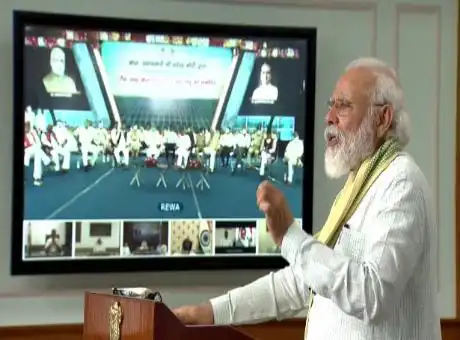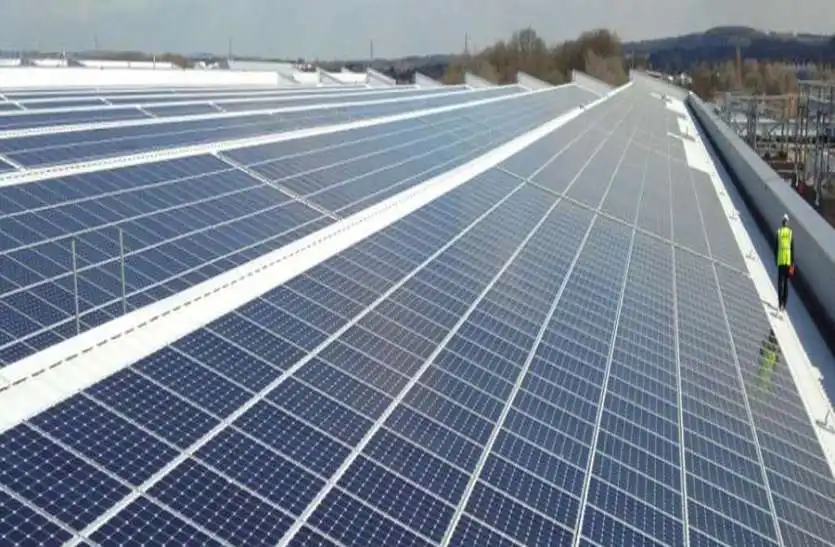Rewa solar plant is Asia’s largest power project situated in Madhya Pradesh,, which is now operational. It is the first project in India to be supplying power to an inter-state open access customer like Delhi Metro. This is also the first project in India where solar power would be used for railway traction. The Solar Power project in Rewa consists of three generating units, each having a capacity of 250 MW. PM Modi inaugurated the solar power project by video conferencing.
How did it all begin for the Rewa Solar project?
The 750 MW capacity was auctioned in three packages of 250 MW each. RUMSL invited bids from solar power developers in January 2017. Twenty firms submitted bids, from which eighteen were shortlisted based on their financial and technical proposal to participate in the bidding process. The reverse auction process for the project involved 33 hours of non-stop bidding by the shortlisted bidders beginning at 10 AM on 9 February 2017. Mahindra Susten, ACME Solar Holdings, and Solengeri Power won the first, second and third units quoting tariffs of Rs 2.979, Rs 2.970 and Rs 2.974 for the first year of operations. In Jan 2017, these were the lowest tariffs ever awarded through a bidding process for a solar project in India, however are now higher than the INR 2.44/unit quoted in the new auctions for the Bhadla Solar Park. International Finance Corporation was the transaction advisor of the project.
About the Rewa Solar project
The project got the World Bank Group’s President’s Award for excellence for its transaction structure. Rewa Ultra Mega Solar is the first solar project in the country to break the grid parity barrier. It is an operational solar park spread over an area of 1,590 acres (6.4 km2) in the Gurh tehsil of Rewa district of Madhya Pradesh. Rewa Ultra Mega Solar Limited (RUMSL), the implementing agency of the project, is a joint venture between the Madhya Pradesh Urja Vikash Nigam Limited (MPUVNL) and the Solar Energy Corporation of India (SECI). Rewa is the first project in India to be supplying power to an inter-state open access customer, viz., Delhi Metro. This is also the first project in India where solar power would be used for railway traction.
The Project secured a place in the book on innovations, ‘New Beginnings’ released by the Prime Minister of India Narendra Modi, which is a publication of the Department of Administrative Reforms & Public Grievances, GoI. Rewa Solar plant is India’s first solar project to get funding from the Clean Technology Fund (CTF), which is available at a rate of 0.25% for 40 years, and from the World Bank. This has enabled Rewa Project to have very low solar park charges, which was one of the contributing features behind the low tariff achieved in the Rewa Project.

Rewa is the first solar project in the country supplying power to an inter-state open access consumer, viz., Delhi Metro Railway Corporation (DMRC). DMRC will be purchasing almost 24% of the project’s electricity generation on a normative basis.
Typically, in power projects, the supply is given proportionally to each of the off-takers. In a solar project, the production varies with solar incidence. Hence, supply to each offtake from a solar project would vary a lot with a time of day and a typical proportionate supply arrangement would not have been able to meet DMRC’s requirement. Hence, RUMS has innovated an optimum scheduling arrangement developed through the first principles to take care of DMRC’s day-time power requirement. Power from the project will be preferentially supplied to DMRC until all of their consumption is met and the balance power will then be supplied to the state. This unique supply arrangement will enable DMRC to meet almost 90% of their day time consumption from Rewa. Apart from expressing Delhi Metro’s commitment to green energy, the benefit to Delhi Metro, considering their current procurement from Discoms at over Rs 6/ unit, is over Rs. 100 crore annually.
The features of Rewa Solar project
- The Solar Park has been developed over a total area of 1500 hectares, by the Rewa Ultra Mega Solar Limited (RUMSL). RUMSL is a Joint Venture of Solar Energy Corporation of India (SECI) and Madhya Pradesh UrjaVikas Nigam Limited (MPUVN).
- One of the world’s largest solar parks, it caught global attention and became an anthem for India’s clean energy evangelists, by landing a then-record low-winning bid of ₹2.97 per kilowatt-hour (kWh) in the country through intelligent risk distribution. By breaking the electricity grid parity barrier in February 2017, the project brought home the point that solar energy is no longer a green fad but a game-changer in India’s energy mix.
- Apart from being the country’s first solar project to conduct the inter-state sale of electricity, the auction process that went on for 33 hours also became the template for awarding future projects in the country.
- It is India’s first such solar project to break the grid parity barrier. In comparison to the tariffs of the prevailing solar project in early 2017 of around Rs 4.50 per unit, the Solar project in Rewa achieved the first year tariff of Rs 2.97 per unit. Moreover, it showed a tariff escalation of Rs 0.05 per unit over the period 15 years and a levelized rate of Rs 3.30 per unit over 25 years.
- The Rewa Solar Power project is expected to reduce carbon emission equivalent to around 15 lakh tons of CO2 per year.
- It exemplifies the commitment of the nation to achieve the 175 GW target of installed renewable energy capacity by 2022. This includes 100 GW of solar installed capacity.
- It is also the first renewable energy project to supply energy to an institutional customer outside the state. From the project, the Delhi Metro will get 24 percent of energy, while the remaining 76 percent of energy being supplied to the state DISCOMs of Madhya Pradesh.
- A perfect example of ‘plug & play’, and how it can bring down solar prices in India.
- An initiative by the state rather than federal companies. Largest solar power tender led by a State and not led by CPSUs.
- Demonstrated that solar energy can become viable on commercial principles and does not need subsidy (Viability Gap Funding).
- The first project in India supplying power to an inter-state open access customer.
- The innovative design of Contracts to address the varying demand pattern of the off-takers.
- Three-tier payment security Mechanism for the procurer – First time in India.
- Innovative Payment Security Fund (PSF) was developed along with Indian Renewable Energy Development Agency (IREDA), based on commercial principles rather than budgetary allocation.
- State discoms will get 76 percent of the power produced from the Rewa solar plant, while the Delhi Metro Rail Corporation (DMRC) will benefit from the remaining 24 percent. The project is estimated to meet up to 90 percent of the day’s electricity demand from DMRC.

The aim of the Rewa Solar project
The Rewa project shows how sustained engagement from project conceptualization to design and bidding, and ultimately financing, can help create a market, well beyond the impacts of an initial set of transactions. Here, we see a package of interventions across the World Bank Group that work together to provide a total solution: the formulation of an approach for implementing large scale grid-tied solar; a package of public sector finance for early-stage derisking, IFC advisory support to concession out three solar power projects, and a package of $437 million in commercial financing to prove the ultimate bankability of the overall enterprise.
India has over 8.5 gigawatts (GW) of solar power capacity and is targeting 100GW by 2022. Of this, 40GW will come from rooftop solar projects. With the renewable-power purchase obligations of power distribution utilities, falling prices of imported solar panels from China and concessional taxation on solar panels, the industry has been growing rapidly, resulting in falling tariffs and a boost for electrical equipment manufacturing and services.
The solar park charges of Rewa were much lower than those for most Solar Power Park Developers (SPPDs) in the country. This was made possible by the land-related charges that were low because of the low cost of land at the project location and the facilitative policies of the Government of Madhya Pradesh. Further, the cost of internal evacuation infrastructure was kept low through the use of MNRE grants under the solar park scheme and mobilization of World Bank loan, of which25% consists of super-concessional loan from Clean Technology Fund, which is available at an interest rate of 0.25% (irrespective of LIBOR). Rewa has been the only Solar Park in the country, till now, to take World Bank loan, as well as loan from CTF. The effect of the concessional World Bank Loan has been to reduce tariff by approximately 5 paisa/ kWh.
Conclusion
The Government of India sees renewable energy as a vital path to meeting its energy needs and has set a capacity target of 175GW by 2022. Wind and solar energy have received special support because of the abundance of these resources in India, rapidly declining equipment costs, lower construction risk and scalability. In the solar sector, the Indian government is providing important incentives: import duty exemption for solar panels; financing of national grid extensions to accommodate solar parks; the obligation for utilities to procure 8 percent of their energy from solar sources by 2022.
Source- niti ayaog, ifc, times of india, financial express

